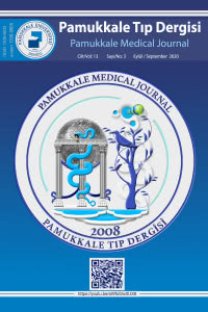Üreteral stent ilişkli semptomlarda 4.0 Fr’e karşın 4.8 Fr double J stentler: ankete dayalı karşılaştırmalı bir çalışma
Üreteral stentler, stent ilişkili semptomlar, USSQ skor, ürolitiyazis, yaşam kalitesi
Ureteral stent-related symptoms in 4.0 Fr versus 4.8 Fr double J stents: a questionnaire-based comparative study
Ureteral stents, stent-related symptoms, USSQ score, urolithiasis, quality of life,
___
- 1. Muslumanoglu AY, Fuglsig S, Frattini A, et al. Risks and benefits of postoperative double-j stent placement after ureteroscopy: results from the clinical research office of endourological society ureteroscopy global study. J Endourol 2017;31:446-451. https://doi.org/10.1089/end.2016.0827
- 2. Sali GM, Joshi HB. Ureteric stents: overview of current clinical applications and economic implications. Int J Urol 2020;27:7-15. https://doi.org/10.1111/iju.14119
- 3. Türk C, Petřík A, Sarica K, et al. EAU Guidelines on diagnosis and conservative management of urolithiasis. Eur Urol 2016;69:468-74. https://doi.org/10.1016/j.eururo.2015.07.040
- 4. Giannarini G, Keeley Jr FX, Valent F, et al. Predictors of morbidity in patients with indwelling ureteric stents: results of a prospective study using the validated Ureteric Stent Symptoms Questionnaire. BJU Int 2011;107:648-654. https://doi.org/10.1111/j.1464-410X.2010.09482.x
- 5. Scales CD Jr., Saigal CS, Hanley JM, et al. The impact of unplanned postprocedure visits in the management of patients with urinary stones. Surgery 2014;155:769-775. https://doi.org/10.1016/j.surg.2013.12.013
- 6. Joshi HB, Newns N, Stainthorpe A, MacDonagh RP, Keeley FX Jr, Timoney AG. Ureteral stent symptom questionnaire: development and validation of a multidimensional quality of life measure. J Urol 2003;169:1060-1064. https://doi.org/10.1097/01.ju.0000049198.53424.1d
- 7. Diatmika AANO, Djojodimedjo T, Kloping YP, Hidayatullah F, Soebadi MA. Comparison of ureteral stent diameters on ureteral stent-related symptoms: a systematic review and meta-analysis. Turk J Urol 2022;48:30-40. https://doi.org/10.5152/tud.2022.21255
- 8. Wu G, Sun F, Sun K, et al. Impact of differential ureteral stent diameters on clinical outcomes after ureteroscopy intracorporeal lithotripsy: a systematic review and meta-analysis. Int J Urol 2021;28:992-999. https://doi.org/10.1111/iju.14631
- 9. Cubuk A, Yanaral F, Ozgor F, et al. Comparison of 4.8 Fr and 6 Fr ureteral stents on stent related symptoms following ureterorenoscopy: a prospective randomized controlled trial. Kaohsiung J Med Sci 2018;34:695-699. https://doi.org/10.1016/j.kjms.2018.07.001
- 10. Nestler S, Witte B, Schilchegger L, Jones J. Size does matter: ureteral stents with a smaller diameter show advantages regarding urinary symptoms, pain levels and general health. World J Urol 2020;38:1059-1063. https://doi.org/10.1007/s00345-019-02829-0
- 11. Damiano R, Autorino R, De Sio M, et al. Does the size of ureteral stent impact urinary symptoms and quality of life? A prospective randomized study. Eur Urol 2005;48:673-678. https://doi.org/10.1016/j.eururo.2005.06.006
- 12. Tanidir Y, Mangir N, Sahan A, Sulukaya M. Turkish version of the Ureteral Stent Symptoms Questionnaire: linguistic and psychometric validation. World J Urol 2017;35:1149-1154. https://doi.org/10.1007/s00345- 016-1958-4
- 13. Fischer KM, Louie M, Mucksavage P. Ureteral stent discomfort and its management. Curr Urol Rep 2018;19:64(e1-7). https://doi.org/10.1007/s11934-018-0818-8
- 14. Cakici MC, Iplikci A, Sendogan F et al. Factors predicting double-j stent migration after retrograde intrarenal surgery. The New J Urol 2021;16:40-46. https://doi.org/10.33719/yud.789879
- ISSN: 1309-9833
- Yayın Aralığı: 4
- Başlangıç: 2008
- Yayıncı: Prof.Dr.Eylem Değirmenci
Rüya MUTLUAY, Çiğdem MENGÜŞ, Neslihan TEZCAN, Emel ISIKTAS SAYILAR, Ulver DERICI, Ceyla KONCA DEĞERTEKİN, Serap GÜLTEKİN, Sevim GÖNEN, Gülten TAÇOY
Mustafa Azmi SUNGUR, Aylin SUNGUR, Fatma CAN, Aycan ESEN, Barış GÜNGÖR, Özlem YILDIRIMTÜRK
Burçin ÇAKAN DEMİREL, Arzu YAREN, Atike Gökçen DEMİRAY, Burcu YAPAR TAŞKÖYLÜ, Tolga DOĞAN, Melek ÖZDEMİR, Taliha GÜÇLÜ KANTAR, Canan KARAN, Serkan DEĞİRMENCİOĞLU, Gamze GOKOZ DOGU
Aslı METE, İlknur Hatice AKBUDAK, Simay SERİN, Hülya SUNGURTEKİN
Secil DENİZ, İrem AKIN ŞEN, Kevser OZDEMİR, Nurefşan AYDENİZ, Ayşe KIVRAK, Simay SERİN, Hülya SUNGURTEKİN, Hüseyin TURGUT
Merve AKTAŞ TERZİOĞLU, Tuğçe TOKER UĞURLU
Bronşektazide öksürme kuvvetinin değerlendirilmesi
Ayşenur YILMAZ, Mukaddes KILINÇ, Orçin TELLİ ATALAY, Melis METİN, Erhan UĞURLU, Hande ŞENOL, Göksel ALTINIŞIK ERGUR
Hakan ANIL, Umut ÜNAL, Ahmet GUZEL
Canlı donörden böbrek naklinde kan basıncının perioperatif yönetimi
